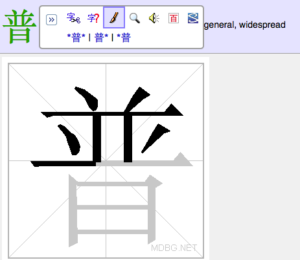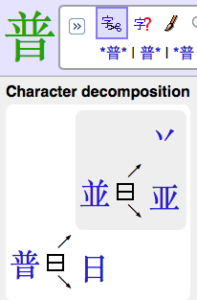Japanese has been my pet project for nearly 2 years. Those of you who have been following the blog closely have seen me update my model flashcard decks, add new plugins, make new video walkthroughs, update my model decks again, and so on. Over the course of trial-and-erroring my way through the language, I now have a clear-cut plan for future learners of Japanese and Chinese.
In this post, I’m going to lay that out for you, so you don’t need to try and piece it together through nearly 2 years of blog posts:
Step 1: Learn Pronunciation
This is the same step 1 as in basically any other language. Get a pronunciation trainer and play around with it for a few weeks. If you’re learning Chinese, you’re going to spend a lot of time learning to hear tones. If you’re learning Japanese, you’re going to get to play around with these cute mnemonics for each letter. If you feel like you have extra time and want to do something with that time, feel free to do steps 2 and 3 while you’re working on the pronunciation trainer’s flashcards.
Step 2: Download and Install a Model Deck
Download one of these model Anki decks and double-click it to install (for help, go here).
- Japanese
- Simplified Characters, Mandarin (Used in Mainland China)
- Traditional Characters, Mandarin (Used in Taiwan, Hong Kong, Macau and by most overseas Chinese)
- Traditional Characters, Cantonese
The decks have a few sample flashcards, but you can just suspend them once you have the model deck installed so they’re not in the way. (Browse -> Gabe’s Japanese/Traditional Chinese/Cantonese/etc Deck -> Select all -> “Suspend”)
Step 3: Learn Your First Radicals
The hardest part of Chinese/Japanese is the work involved in memorizing the characters (things like 芸). If you want to have a shot at actually remembering them, you’re going to want to memorize their constituent parts (艹 + 二 + 厶 = 芸). Those constituent parts are called ‘radicals,’ and every character is composed of some combination of 1 or more radicals. At this stage, you’re going to give yourself a head start, by memorizing ~50 of the most commonly used radicals.
You already have pre-made flashcards for those radicals in the model deck you installed in Step 2, but you need to spend some time customizing those flashcards so that they actually work for you. When you’re ready for this step, follow the instructions here (they start at “How to make this deck your own”). Ignore the part about downloading a deck, since you already did that in step 2.
Step 4: Get Your Information Sources Prepared
We need to get you ready to learn words, ideally in the context of a sentence. To do that, you’re going to need these ingredients :
- Words to learn
- Stroke order diagrams for the characters in those words
- A way to break the characters down into their constituent parts
- Example sentences for those words that are simple and clearly understandable (optional at first but get to these ASAP)
- Recordings of either the example sentences or the individual words
- Images of the words or the stories in the sentences
So go through this list, item by item, and figure out ahead of time where you’re going to find each piece of information. I’ll give you my suggestions, but feel free to add more in the comments!
Japanese Information Sources:
- Words to Learn: Start with the 625 List
- Stroke Order Diagrams: I use this Anki plugin because it’s automatic. If I wasn’t using that, I’d use Jisho.org, which is a part of the Japanese Multisearch.
- A way to break the characters down into their constituent parts: I use Kanjidamage.com. It doesn’t work well with Multisearch (you need to re-paste your word, one character at a time into their search box, but it’s a good enough resource that I do that anyways)
- Example Sentences for Words: I highly, highly encourage you to get these from a tutor on iTalki.com. One hour (for $5-8) spent taking words from the word list and coming up with sentences together will give you enough content to learn for a full week, if not more. If not this, then there are some example sentences at Jisho.org.
- Recordings of the words/example sentences: I record my Skype calls, write down the time that my tutor says each example sentence, and go back into that audio file and make mp3s for each sentence. This is a lot of work, and we’re in the process of creating a web app to make this process simpler. If it seems like too much work, you can grab recordings of whatever individual word you’re learning off of Forvo.com, which is a part of the Japanese Multisearch.
- Images of the words or the stories in the sentences: Google Images isn’t as good in Japanese as it is in English. I tend to search in Japanese first (as a part of the Multisearch) just to see what comes up, but 80% of the time, I get my images by searching in English. I don’t find this super problematic as long as I’m working with sentences, rather than individual words, since the context of each sentence tends to give me a lot of extra information that I might lose if I was learning the words alone with exclusively English-sourced pictures.
Link to the most up-to-date Japanese Multisearch. Right-Click (control-click for Macs) and select ‘Download Linked File’
Chinese (Mandarin/Cantonese) Information Sources:
- Words to Learn: Start with the 625 List
Stroke Order Diagrams: This Anki plugin is designed for Japanese, but the developer has added more Chinese support, so you may find that it ultimately saves you time to use it anyways. because it’s automatic. If I wasn’t using that, I’d use MDBG.net, which unfortunately doesn’t work well with our current Chinese multisearch, so you currently have to re-paste your word into their search engine. But they do offer animated gifs of the stroke orders (see diagram on the right)A way to break the characters down into their constituent parts: MDBG.net, once again, is a really nice resource for this.
- Example Sentences for Words: I highly, highly encourage you to get these from a tutor on iTalki.com. One hour (for $5-8) spent taking words from the word list and coming up with sentences together will give you enough content to learn for a full week, if not more. If not this, then there are some example sentences at LINEdict.com (Mandarin) or at Cantonese.sheik.co.uk (Cantonese).
- Recordings of the words/example sentences: I record my Skype calls, write down the time that my tutor says each example sentence, and go back into that audio file and make mp3s for each sentence. This is a lot of work, and we’re in the process of creating a web app to make this process simpler. If it seems like too much work, you can grab recordings of whatever individual word you’re learning off of Forvo.com, which is a part of the Chinese Multisearch [but this is going to be way more limited in Cantonese than Mandarin. I feel like for Cantonese, you’re really shooting yourself in the foot if you’re not getting recordings from a tutor]
- Images of the words or the stories in the sentences: Google Images isn’t as good in Chinese as it is in English. I tend to search in Chinese first (as a part of the Multisearch) just to see what comes up, but 80% of the time, I get my images by searching in English. I don’t find this super problematic as long as I’m working with sentences, rather than individual words, since the context of each sentence tends to give me a lot of extra information that I might lose if I was learning the words alone with exclusively English-sourced pictures.
Link to the most up-to-date Mandarin Multisearch. Right-Click (control-click for Macs) and select ‘Download Linked File’
Link to the most up-to-date Cantonese Multisearch. Right-Click (control-click for Macs) and select ‘Download Linked File’
Step 5: Start Learning Words in Anki
The card model I use for Japanese/Chinese is enormous. It’s going to take you some time to get used to it, and creating your first cards is going to be sloooowww. So be prepared for that. It gets faster. The nice thing about that card model is that for a typical word, you might generate 10 flashcards worth of content to study, so all of that time spent preparing those flashcards tends to pay you back.
To learn how to use the flashcard model, read this article about “Kanji Signatures” and watch the video inside of it. Although I’m talking about Japanese, all of the concepts apply in the same way to Chinese. To quickly summarize the concept of Kanji Signatures, basically it’s the idea of adding a flashcard that asks you about the first two radicals in any given character, so if you’re trying to learn 芸, then that flashcard is asking you to JUST remember 艹 + 二. This ends up being super helpful when it comes to building a good memory for that character, since you’re training yourself to start the character correctly, which usually lets you finish it more easily.
Since I wrote that article, I found that there’s one more thing that you can (and should) do when learning characters. Make more mnemonics. All the time. Any time you see a new radical, make a new mnemonic for it. Any time you see two old radicals used together, make a new mnemonic for it (厶 = cow. 二 = nickel, 二 + 厶 = decapitated cow). The bottom of the flashcard model has two fields for making new mnemonics. Plan to use them very, very often. I had something like 500-1000 mnemonics I was using in Japanese. They were never particularly hard to remember and they always helped when remembering new characters. Really, the hardest part of my daily flashcard reviews were always the older characters that I didn’t do this with. If I did Japanese over again, I’d go back and make way more mnemonics.
Step 6: Keep Going
If you’re learning these words in sentences…and especially if you’re learning them in sentences that you’re developing with a tutor, then you’ll find that after you finish the 625 list, you can actually have conversations in your target language. You’ll be missing a lot of vocab, but still, you’ll be at a pretty solid intermediate level. You’ll also find that you don’t need to learn new characters/stroke orders/radicals all that often. To keep going, move to learning the top 1000 words in a frequency dictionary. Use the Routledge ones (Japanese, Mandarin, not available in Cantonese) if you can.
Keep making sentences with a tutor that involve every one of the words you don’t yet know in those top 1000.
Step 7: The Language Game
Once you complete those (this will take 1-3 years – these languages are incredibly data heavy due to the characters), you’re going to be at a high intermediate level and in a pretty solid position to play with whatever you want to play with, as per Chapter 6 in the book. You should be in decent shape to watch movies/tv, listen to audiobooks, etc. You’ll still have a lot to learn, but your foundation is going to be rock solid and taking in new information is going to be way, way easier.
Good luck, and I’ll see you on the other side. For my own studies, I’ve had to put Japanese on hold (I’m 30% the way through Step 6) while I spend 6 months on Spanish so I can talk to my in-laws at my wedding, then I’m going back to Japanese to finish the job. So you have some time to start catching up to me, and then we can finish together 🙂
-Gabe
For additional Japanese language learning resources to help you on your journey to fluency, check out our comprehensive free-to-use list right here.




 A way to break the characters down into their constituent parts:
A way to break the characters down into their constituent parts: 

